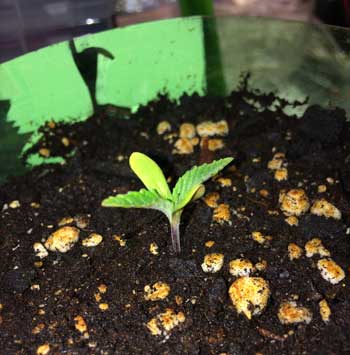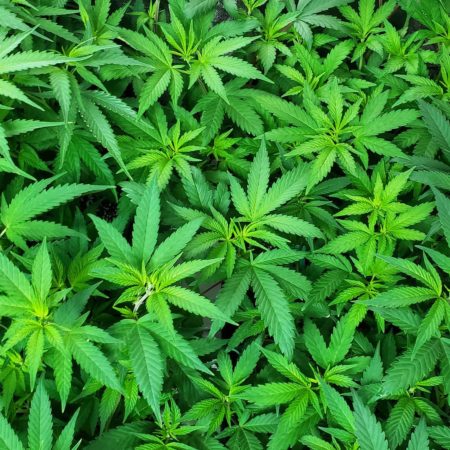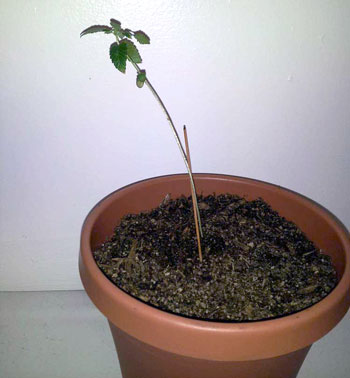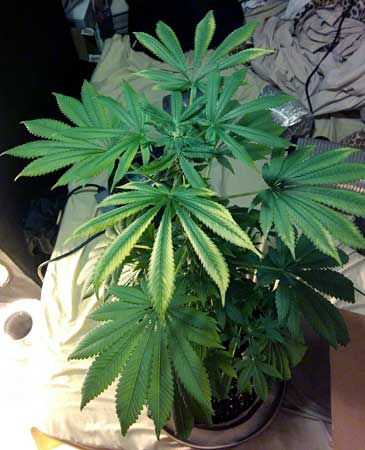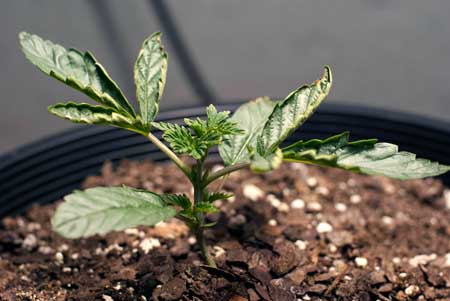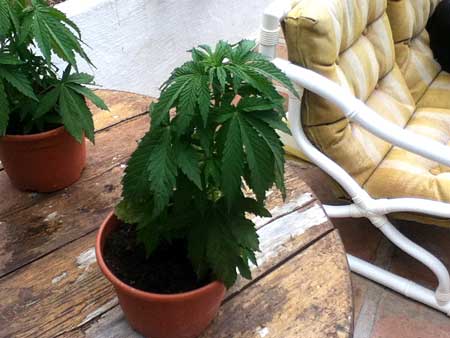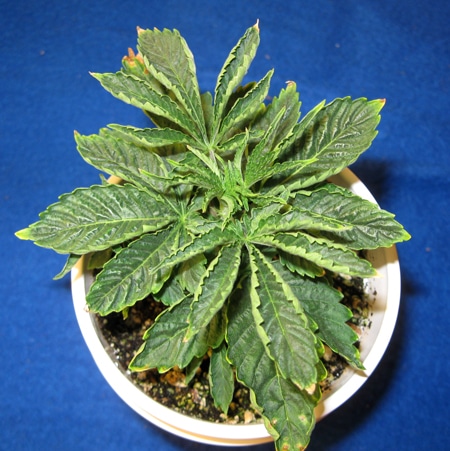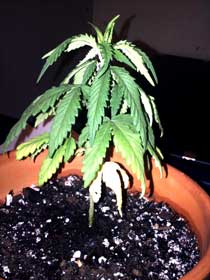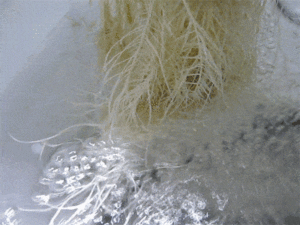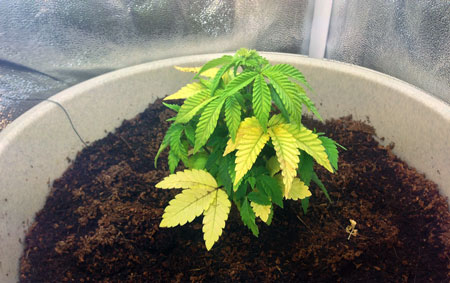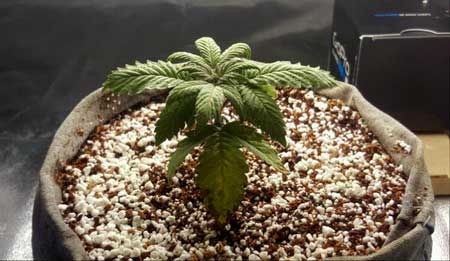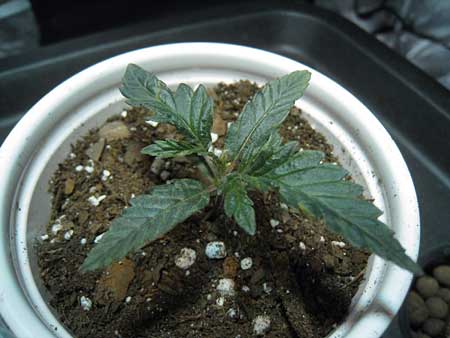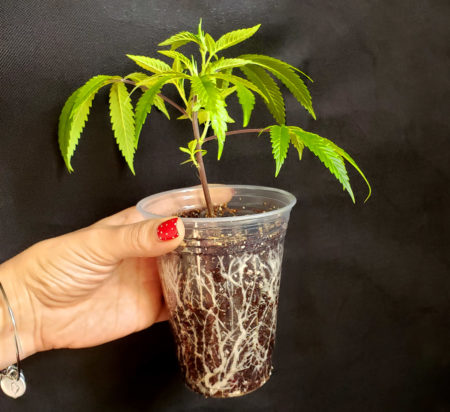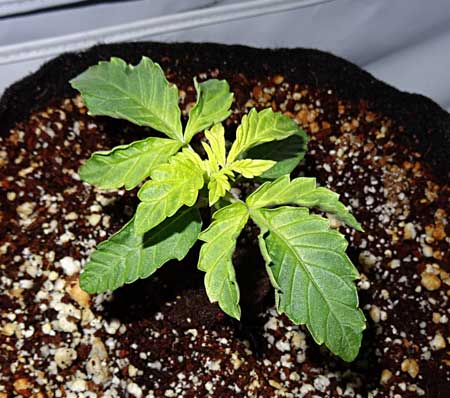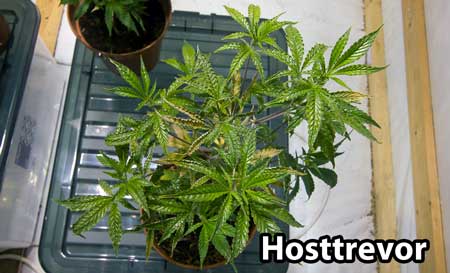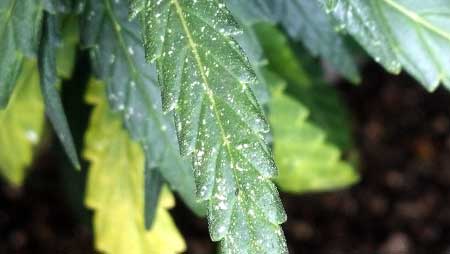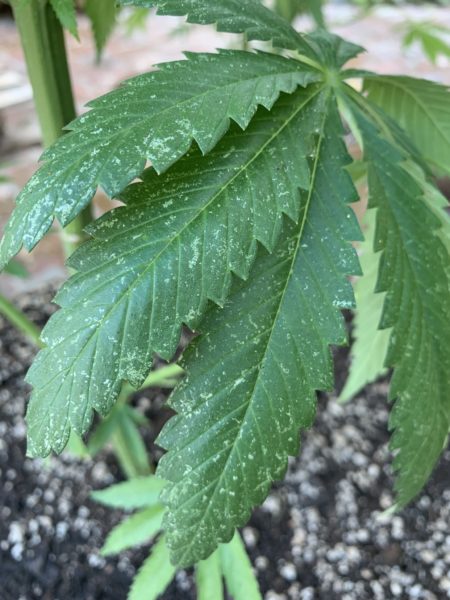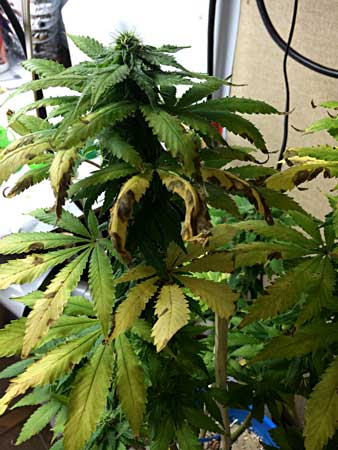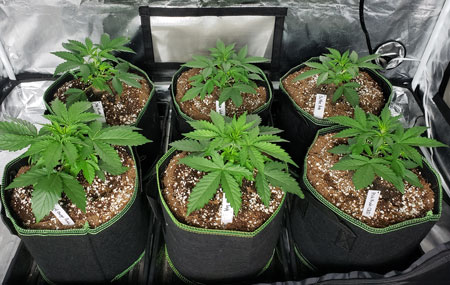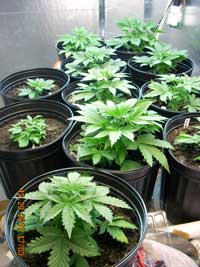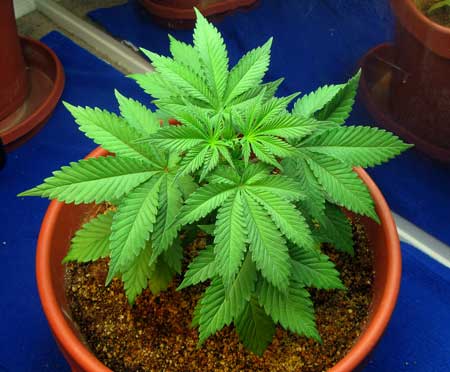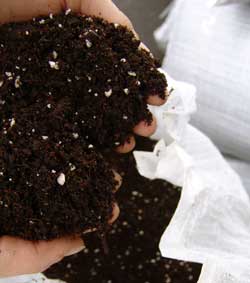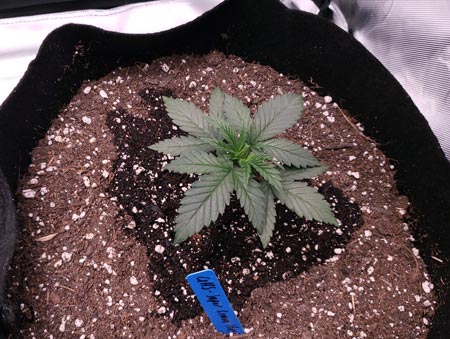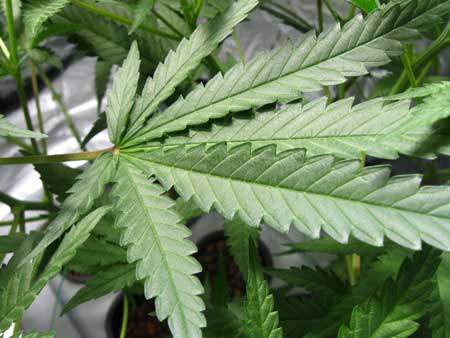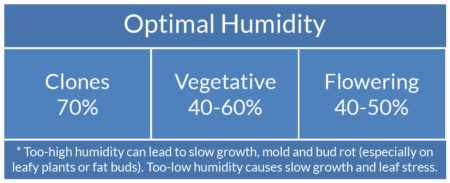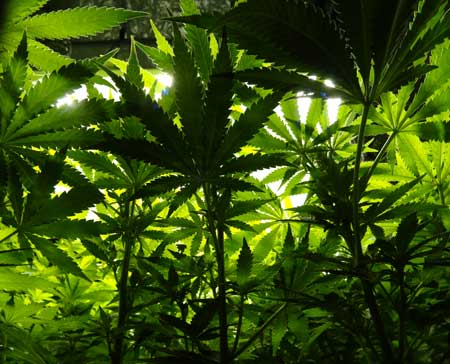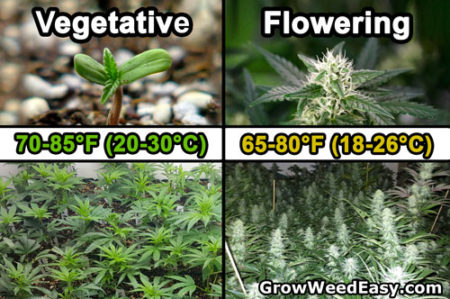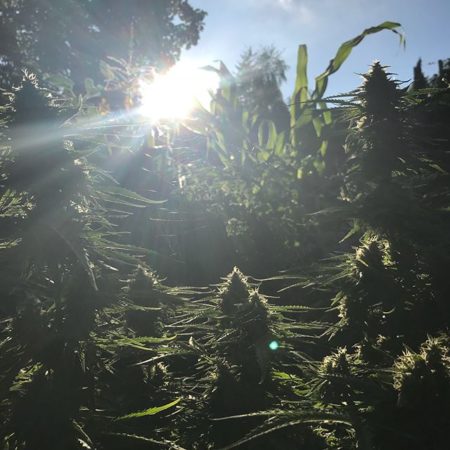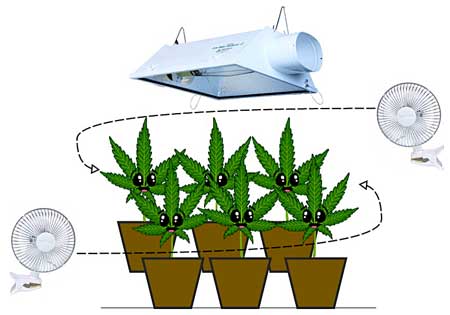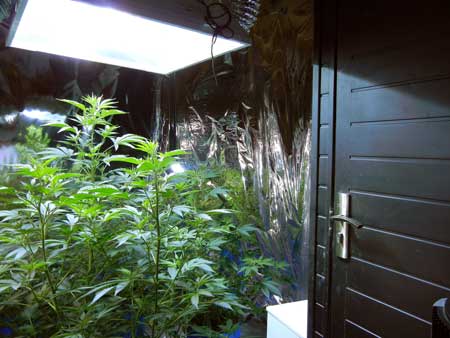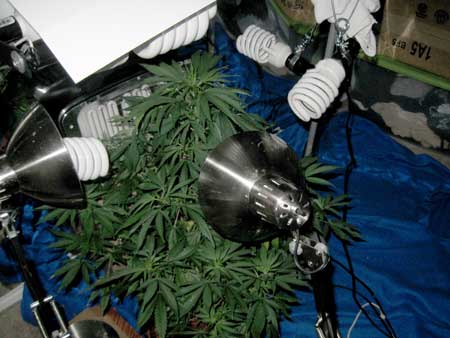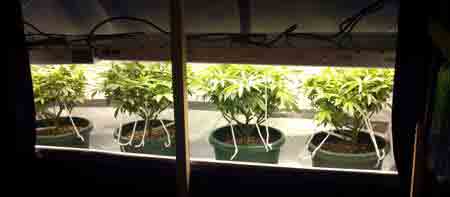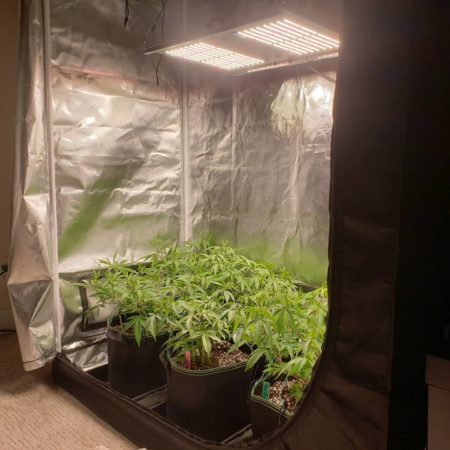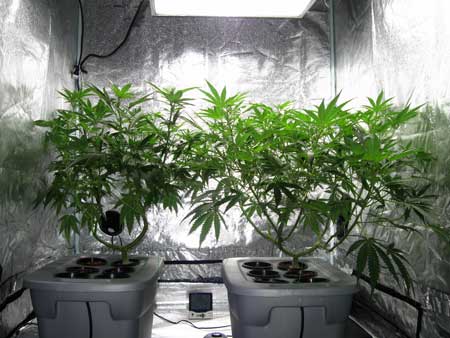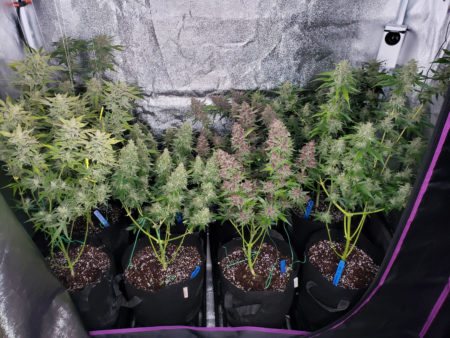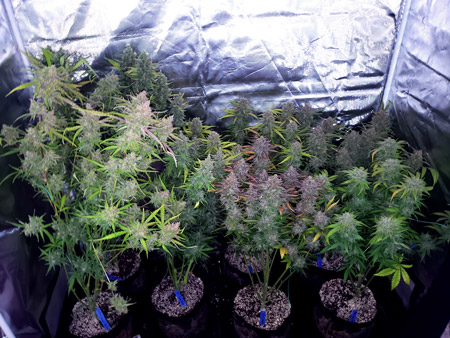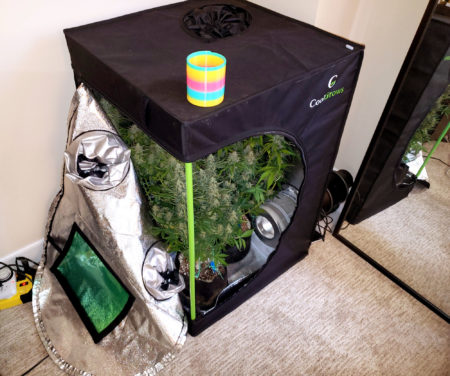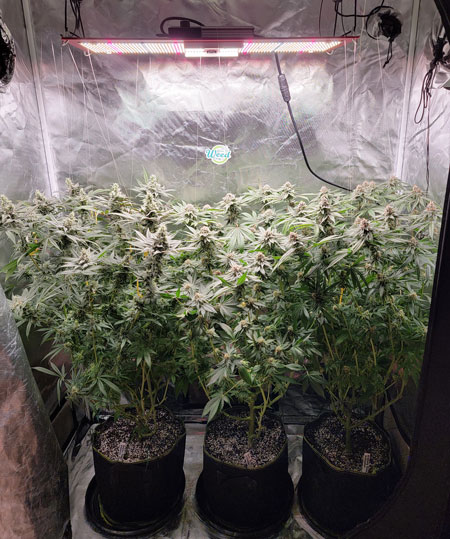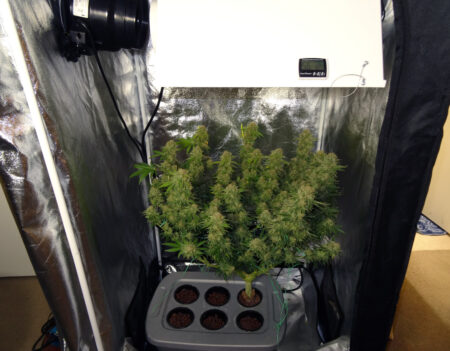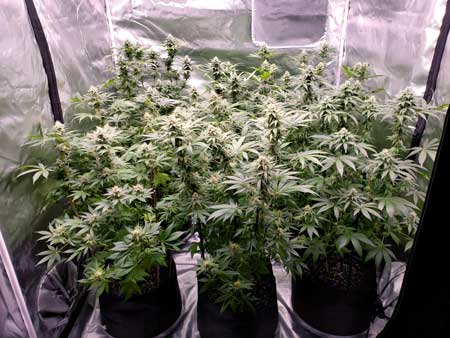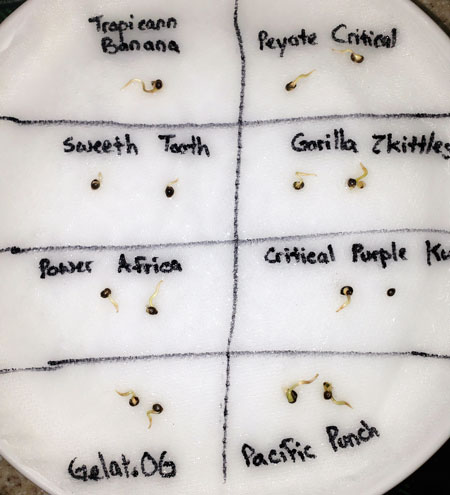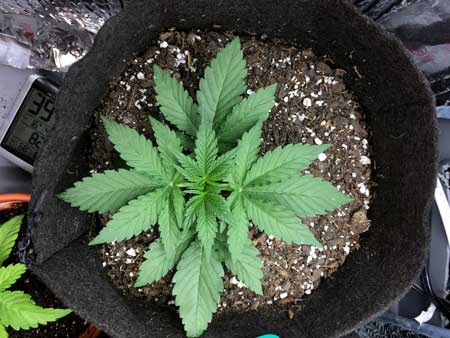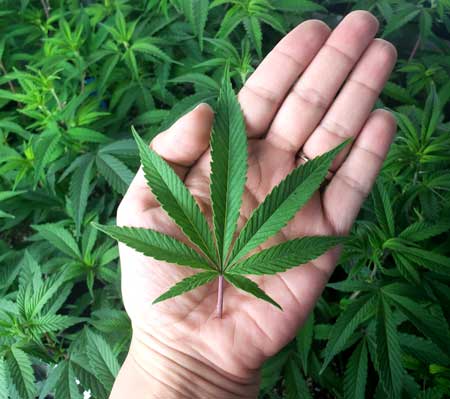by Nebula Haze
Why are your cannabis plants staying small? You planted your seeds, seedlings appeared, but now your plants are growing soooooo slow. It’s a common problem with cannabis seedlings and vegetative plants, but often frustrating to figure out the fix. What’s the cause? How do you make your marijuana plants grow faster?
Slow-growing cannabis plants are a common problem for growers. In today’s tutorial, you’ll get the solution!
This tutorial will help you overcome the 7 main causes of sluggish growth, so your cannabis plants grow blazingly fast.
You’ll learn how to make plants grow fast and healthy
Note: This article is about slow-growing seedlings and vegetative plants. If you’re in the flowering stage, check out these articles about buds taking forever to mature, increasing yields, and improving bud density.
7 Most Common Reasons Plant Growth is Slow
Here are the 7 most common reasons your seedlings or young plants are slow-growing:
1.) Grow Light
Plants tend to grow slowly if they’re not getting enough light overall. If slow growth is combined with long, lanky seedlings, your plants need more light. In that case, either increase the power of the light, bring it closer, or get a bigger grow light.
Tall seedlings need more light (grow light is too far away)
You can also give plants too much light. Powerful grow lights cause stress and can slow down plants if they’re kept too close.
Too much light (when the grow light is too close) results in stress and unusual symptoms that can slow down plants
2.) Extreme Environment
Cannabis plants enjoy a warm sunny day. Not too dry, not too humid. Similar to humans, actually. Certain strains are more resistant to an extreme environment, but plants grow best in moderate humidity and warm-but-not-hot air. A good temperature range is warmer than 70°F (21°C) at night and around 79°F (26°C) during the day. Humidity around 50% is perfect.
Temperature
- Cold temperatures below 60°F (15°C) may slow growth down to a crawl, and freezing temperatures can kill.
- Heat above 85°F (30°C) can also slow down growth or even slay plants if it stays too hot for too long.
Humidity
- Dry air under 35% RH can limit growth, and under 25% RH you may even start seeing signs of deficiencies on the leaves and other odd symptoms.
- High humidity above 65-70% can make weed plants droopy and slow down growth by making it harder for the plant to move water efficiently through the plant.
Cannabis seedlings have the most trouble dealing with a poor environment, while older plants tend to be more resistant to temperature and humidity.
This seedling is struggling to cope with a hot, dry environment.
Note: For the fastest growth, keep the temperature around 79°F (26°C) during the day and a little cooler at night. The optimal humidity is around 50%.
Cold temperatures can also stunt plants or make them grow at a snail’s pace. This poor plant experienced a cold night under 50°F/10°C and was droopy the next morning. It took several days for the plant to recover and start growing normally again. To make things worse, cold temperatures cause plants to drink less, so they’re more likely to suffer from symptoms of overwatering when the temperature falls.
Effects of cold
While we’re talking about an environment, what about a breeze? How much fan does an indoor cannabis plant need?
Although fans help equalize the temperature of your grow area, a too-strong breeze can slow down seedling growth. Leaves should be gently rustling but you shouldn’t see stems waving around in the wind. If that happens, turn down the fan or point it in a different direction. Learn more about fans and circulation.
3.) Unhappy Roots
Unless you’re growing in a hydroponic setup, chances are your plant roots are hidden from view. Yet roots affect plant growth just as much as the environment above the ground. When the roots are unhealthy or unhappy, a plant languishes and stops growing. When roots are getting what they need, a plant can grow inches a day.
Unhappy roots = Unhappy plants
The most common cause of unhappy roots is overwatering, especially for seedlings and young plants. Overwatering is typically the result of giving too much water at a time, or watering too often. Some strains are much more prone to being overwatered than others.
But isn’t water good for the plant? The problem is that roots also need oxygen, which they typically get through air pockets in the soil. If the soil gets waterlogged from too much water without any pockets of air, the roots start “drowning” from lack of oxygen. The lack of oxygen is what causes the symptoms of drooping and slow growth.
Roots get oxygen from air pockets in the soil. If your soil is soaked for too long, all the oxygen gets used up and plants get sick from lack of oxygen at the roots.
In hydroponic growing, oxygen is provided to roots through bubbles. That’s why hydroponic plants don’t get droopy even though their roots live directly in water.
Overwatering is most common when you have a small plant in a big pot because the roots aren’t drinking much yet. Luckily, this can be overcome with proper seedling watering practices. Yet even if you’re watering plants perfectly, a poor draining grow medium (such as thick muddy soil, or a pot without drainage holes) will still trigger root problems and slow growth due to lack of oxygen at the roots.
The following symptoms of droopiness and yellowing are the result of a thick grow medium, small plant in a big pot, and chronic overwatering.
Overwatering – This seeding is almost a month old but it’s stayed small due to being watered too much and too often.
Underwatering is less common but may be even worse for seedlings. Underwatered seedlings grow slow, stay small, and often have a dark coloring.
Underwatering – When plants don’t get enough water, they grow slowly and may turn dark green.
If your plant stays in a too-small pot without any room to spread out its roots, growth slows and plants stay small. If you start seeing droopiness and deficiencies on a plant that has been in the same pot for a while, it may be root bound (the roots have wrapped around the edges of the container). This causes symptoms similar to over/underwatering but is difficult or impossible to overcome with watering practices.
With a heavily rootbound plant, you may need to transplant it to a bigger pot to stop the symptoms. Try to avoid disturbing roots during transplant (try to keep roots in a solid bunch and put the rootball directly into a hole in the new medium) so you don’t unintentionally stress the roots from being moved around too much.
Rootbound – This seedling will grow faster and get bigger if it’s moved to a bigger container so roots can spread out
4.) Nutrient Deficiencies
Cannabis seedlings in soil don’t need extra nutrients right away, as they can find nutrients in the soil. However, if the pH (acidity) at the roots is too high or low (6-7 pH is ideal for soil), seedlings can’t absorb the nutrients properly and may get nutrient deficiencies anyway. This is because nutrient compounds at different pH ranges take different chemical forms. At the “right” pH, it’s much easier for your cannabis roots to absorb nutrients. So even when growing in rich soil that has plenty of nutrients, you as the grower should make sure the pH at the roots isn’t too high or too low, typically by using PH test strips on your water.
Plants grown in coco or hydroponics do need to receive extra nutrients in the water from when they’re seedlings. Because plain water and coco don’t contain much nutritional value, the only nutrients plants get are the ones you give them. That means if you’re not giving any nutrients, the plants will grow extremely slowly, then eventually turn yellow and die. Just like with soil, coco and hydro growers also need to adjust the pH of their water to ensure nutrients are absorbed properly. In coco or hydro, the optimum range is 5.5-6.5 pH.
If you’re seeing nutrient deficiencies, chances are your plant isn’t growing as fast as it could. This seedling is growing slowly due to an iron deficiency caused by high pH at the roots (it’s also overwatered, which isn’t helping).
5.) Bugs or Other Pests
Unfortunately, plant pests like broad mites, spider mites, thrips, or even a ton of fungus gnats can slow down growth as the plant spends energy repairing the damage. Sometimes growers mistake the symptoms for a nutrient deficiency or other problem. If you’re noticing spots, patches, or anything unusual on your leaves, don’t ignore it!
Here are some common cannabis pests…
Broad mites are too small to see, but if they infest your plant they cause leaves to look shiny.
Spider mites munch on your plants and create small yellow specks all over your leaves. You may also see webbing.
Thrips also make speckles on your leaves, though they appear in irregular patches as opposed to individual specks. Often mistaken for a nutrient deficiency.
Fungus gnats look like tiny flies buzzing around your soil and usually aren’t too serious. Just water the plant less often and let the topsoil dry out between waterings. However, in big numbers, they will hurt plant growth, especially on smaller plants. The following symptoms are caused by an extreme fungus gnat infestation. At this point, it can be harder to get rid of them.
6.) Genetics & Natural Variation
Genetics make a difference. Some strains simply germinate and grow faster than others. On top of genetics, seed age and storage matter to your plant’s growth rates, especially at first. Older seeds tend to germinate slower and plants are often slower growing as seedlings. Seeds stored in extreme temperatures may also be harder to germinate and easier to stunt. However, if seeds germinate and you give proper care, you should be able to quickly get plants to start growing faster.
These six autoflowering plants are about 3 weeks old and all different strains. They were germinated on the same day and grown in the exact same environment, yet some are bigger than others. All have been growing quickly and healthy without any problems, so the main difference may be genetics.
Even if genetics are the same, you can give the same care and end up with different growth rates between plants. For example, if you take multiple clones and grow them in the same garden, some will grow faster despite the fact their DNA is literally identical. That’s just the way nature works. So if you’re noticing only one plant growing slowly, while all the others seem fine, that’s a sign you may just have a runt on your hand. It might have nothing to do with you.
Even when plants have the same genetics and are grown in identical conditions, sometimes you end up with runts. That’s a natural part of growing and it may not be your fault.
7.) Sometimes Plants Want to Be Left Alone
Unfortunately, you can “over-love” your plants. Overwatering is so common among new growers because they are trying to give something good to their plants and get a little carried away.
Sometimes plants need to be left alone. There may be days or even weeks where they really don’t need anything from you besides water.
If you’re wondering why plants are growing slowly, yet you’re constantly messing with plants, touching them, bending them, defoliating, etc., you may need to give them a break until they start growing fast again. Fast-growing vegetative cannabis plants can handle almost anything, but when a plant is growing slow you should focus on providing a good environment, just the right amount of nutrients/water, and staying hands-off until it’s recovered.
Sometimes plants just need time to “do their thing” by themselves.
How to Make Cannabis Plants Grow Faster
Now that you know what may be causing the problem, get the solution. Follow these principles and your plants will be growing inches a day!
1.) Watering
Proper size pots – Much easier to avoid over or under-watering if plants are in an appropriately sized pot. Seedlings grow fastest in small pots where they’re less likely to get waterlogged, while older plants want bigger pots to spread out their roots. What size pot should I use?
Good drainage – Soil or coco should not seem muddy, dense, or thick. Water should be able to drain freely from the bottom of the pot (if there aren’t any drainage holes, you need to add some yourself). Learn about growing in soil or coco.
Good soil or coco has a texture similar to this
Aim for watering every 1-3 days – Giving just enough water at a time so you can water every 1-3 days produces the fastest growth. Watering every day produces excellent growth but you have to be careful not to give too much at a time. It takes a delicate dance to avoid overwatering when watering that often. I recommend aiming for every 2-3 days for beginners since there’s less room for error.
You may only need to give just a little water at a time when plants are small and not drinking much yet.
Plant pots should be feeling a little light and the topsoil should be dry or mostly dry by the time you give water again. If you’re giving so much water at a time that it takes 4+ days for your grow medium to dry out, you likely will achieve faster growth by giving less water at a time. However, some growers prefer a hands-off approach to growing and may not mind plants growing a bit slower if it means they get to water less often. If you need to water more than once a day, the plant is begging for a bigger pot. Read the full watering tutorial.
Nutrients and PH – Make sure your plants are getting the necessary nutrients. As far as pH, some growers get lucky and happen to have perfect water for cannabis plants. However, if your plants are struggling and you don’t know why, the pH being high or low is one of the most common reasons. If your plants are struggling and you haven’t checked the pH at all, get a PH Test Kit and do that first. It’s super simple to adjust the pH (just add “PH Up” or “PH Down” to your water), you just need to know how much to add, and you can’t find that out without testing! Learn everything you need about nutrients and pH.
2.) Environment
Humidity – Keep humidity around 50% RH for the fastest possible growth. Plants can grow at higher or lower humidity levels, but some plants struggle because humidity affects how well water moves through the plant. Since each leaf is constantly giving off water vapor, it’s more common for growers to struggle with high humidity than low humidity, but it still goes both ways.
- Dry air under 35% RH can limit plant growth, and under 25% RH may even cause deficiencies and other odd symptoms
- High humidity above 70% often makes plants droopy and slows down growth. In the flowering stage, high humidity can cause buds to grow more fluffy.
If your air is dry, you may consider turning down any fans to help keep humidity pockets near your plants, though that can only do so much. If the air is really dry, you may need to add a humidifier (raises temperature and humidity) or swamp cooler/evaporative cooler (lowers temperature, raises humidity).
If you’re struggling with high humidity, you may need to add an exhaust fan to vent out humid air and bring in fresh air. If your plants are in a grow tent, typically an exhaust fan that’s set up properly can keep the humidity just a little higher than in the room. If the humidity is much higher in the grow space than the surrounding room, that means you need to help equalize the air with an exhaust/intake fan, or by blowing the air around. If the humidity of your actual room is high, no amount of fans can fix that. In that case, you’ll need either a dehumidifier (raises temperature, lowers humidity) or an AC (lowers temperature and humidity) to bring the RH into a better range. Read the full humidity tutorial.
Extra leafy plants tend to raise the humidity of a space because each leaf is constantly giving off water vapor
Temperature – Cannabis seedlings and young plants love when it’s warm but not hot. Plants typically grow the fastest if the temperature stays around 73°F (22°C) at night and 80°F (27°F) during lights-on. Under LEDs, you can keep it a few degrees higher without issue. Plants can definitely grow well when it’s a bit warmer or cooler, but you tend to get the fastest growth within that temperature range.
Most growers can’t choose the exact temperature down to the degree, so here’s a more realistic temperature chart.
If the environment is nice for you, it’s probably nice for your plants
Gentle Air Circulation – You probably know if it seems stuffy in your grow space. Plants, like humans, enjoy a gentle breeze to go along with their warm, sunny day. Air circulation prevents hot spots while ensuring plants get plenty of access to fresh air. Fresh air contains CO2, which is crucial to photosynthesis (making energy out of light). As a result of fresh air and great air circulation, plants not only grow faster with stronger stems, they are more resistant to white powdery mildew, bud rot, fungus gnats, spider mites, and other unwanted visitors.
Quick Cheat Sheet to Fixing Environment
- Fans – Fans equalize the temperature and humidity between two areas by moving air around. Just remember that they cannot alter the overall temperature or humidity. For that, you’ll need….
- Humidifier – Raises temperature, raises humidity
- Swamp cooler/evaporative cooler – Lowers temperature, raises humidity
- Dehumidifier – Raises temperature and lowers humidity
- Air Conditioner (AC) – Lowers temperature, lowers humidity
A great environment produces fast-growing plants!
3.) Optimize Your Grow Lights
Choose a quality grow light and keep it the recommended distance away from your seedlings for the fastest growth. Usually, the manufacturer of a grow light will have instructions on the proper distance from plants. However, sometimes you’ll see signs of light stress and may need to keep lights further away than recommended, especially for younger plants. If the light feels hot on your hand where your plants are, it definitely should be moved further away. Some of the fastest vegetative growth I’ve seen comes from CMH/LEC grow lights with a vegetative bulb, but most grow lights produce great vegetative growth when used correctly.
Grow light tips to produce excellent vegetative growth:
CFLs (Old tech, get LEDs instead!) – These used to be popular for small cannabis grow lights, but LED grow lights are better than CFLs in almost every way (better yields, less heat, higher bud potency, better bud density, etc.). However, if for some reason you are using CFLs, here’s what to do. Keep CFLs as close as possible while making sure plants don’t grow into a bulb. After plants are established, you can keep CFLs only inches away. Use the “hand test” to determine if CFLs are too close: put your hand at plant height for 30 seconds, if it feels hot the CFL should be moved further away. CFL bulbs with a spectrum of 6500k are best for seedlings and vegetative plants, and 2700k bulbs should be added in the flowering stage.
CFLs are old technology. Get an LED grow light instead!
T5 High Output Fluorescent light (Old tech, get LEDs instead!) – Traditional T5 grow lights are fluorescent lights like CFLs, and similar principles apply. If at all possible, try to upgrade to an LED grow light. If you are using T5s, keep the bulbs as close as possible without stressing or burning plants. T5s produce more intense lights than CFLs and often need to be kept further away. Follow the manufacturer’s specifications for distance, or start at 12″ away if you’re not sure and move a little closer each day. Use the “hand test” to determine if a T5 is too close. If the T5 feels too hot for your hand at plant height, it’s probably too hot for your plants. T5s are best for the vegetative stage but can support plants in the flowering stage if you train plants to grow flat and short like the ones pictured here.
*What is an LED “T5” grow light? It’s basically an LED grow light in the shape of a traditional T5. The term “T5″ is based on the width of the fluorescent bulb (5/8”) so labeling an LED grow light as a “T5” is just a marketing gimmick. From what I’ve seen, LED “T5” lights are just like regular LED grow lights.
T5 grow lights are old technology. Get an LED grow light instead!
LEDs – LED grow light technology has improved by leaps and bounds over the last decade but especially in the last 2-3 years. There are good and bad brands out there, but many newer LEDs are designed specifically for growing cannabis and tested on live plants. The best LEDs produce captivating bud quality and yields, so the brand you choose is important. Since each model is so different, you should always check the manufacturer’s specifications to determine the proper distance to plants. In addition to paying attention to the brand and light distance, some LED lamps are configured to be optimum for the vegetative stage, the flowering stage, or an “all-in-one” mix.
I’ve found that LEDs configured for the flowering stage (like the HLG 300L R-spec) can get slower growth with young plants, but performs well in the vegetative stage and produces impressive yields/bud quality in the flowering stage. If you have to choose just one LED light, it’s often best to choose one configured for the flowering stage to maximize your yields, even if it does mean plants grow slightly slower at first. An all-in-one LED lamp like the Spider Farmer SF-2000 still gives you great flowering results with faster seedling growth. However, these types of all-in-ones may not perform quite as well in the flowering stage as a specialized flowering lamp as far as bud potency.
Hobby-level LED grow lights at full power typically need to be kept 2 feet (60 cm) away from young plants. Some models need more or less distance. Some models can be dimmed for younger plants or heat control. Since every LED model is different, it’s always a great idea to start at the distance recommended by the manufacturer. LEDs can usually be kept closer as plants get bigger, while seedlings need more distance.
Metal Halide (MH) – Metal Halide grow lights produce bushy, healthy, fast-growing vegetative plants. Traditionally, indoor growers used MH lights for the vegetative stage to keep plants short, then switched to an HPS bulb for the flowering stage for the biggest buds. As LED technology has improved, MH/HPS lights have fallen out of favor for LEDs. However, MH/HPS may be a good fit for growers on a budget. Learn how far to keep MH from plants. Note: The bigger sizes (especially 400W and up) can get extremely hot unless you vent out the heat with an exhaust fan.
High Pressure Sodium (HPS) – MH and HPS usually go together. Most fixtures that can take a MH bulb can also take an HPS bulb of the same wattage. HPS bulbs produce great yields in the flowering stage, but plants in the vegetative stage grow tall and stretched under HPS no matter how close the bulb is kept. If you have an MH/HPS ballast, get an MH bulb for the seedling/vegetative stage so you produce wide plants with close node spacing. Then swap to the HPS bulb after you’ve initiated the flowering stage. Note: HPS produces comparable heat to MH, which means above the 400W size they almost always need to be vented to control heat. However, the smaller MH/HPS sizes such as 150W and 250W run much cooler.
These plants are tall and lanky because they were grown under a 250W HPS as from seedling to harvest. The grower should have started with a 250W MH bulb in the fixture during the vegetative stage, then switched to the HPS bulb after plants started making buds. View the grow journal.
CMH/LEC – Each model is a bit different, so refer to the specifications from the manufacturer to determine the best light distance to plants. CMH bulbs often need to be kept further away than MH/HPS bulbs of the same wattage. CMH grow lights (also known as LEC) also have two different spectrum bulbs that can be used. The 4000k/4100k bulb (more blue) produces some of the fastest vegetative growth I’ve seen of any grow light. It’s kind of astounding. The one downside is vegetative plants do grow a little taller/stretchier under CMH than under an MH or many LEDs. The 3100k (more red) CMH bulb performs similarly to an HPS, so try to avoid it during the vegetative stage if possible.
These plants were grown under a 315 LEC grow light with a 315W Philips Bulb
Recommended grow lights
2’x2′ Grow Tent – Small
- Ultra short edition – 3′ tall
- 65W – HLG 65 LED Grow Light
- 1-3 oz per harvest
- $300 to get started
- Room to grow – 4′ tall
- 100W – SF-1000 LED Grow Light
- 2-4 oz per harvest
- $430 to get started
Example of a 2’x2′ grow tent
2’x4′ Grow Tent – Medium
- Standard Power – 5′ tall
- 200W – SF-2000 LED grow light
- 5-11 oz per harvest
- $555 to get started
- Max Power – 6′ tall
- HLG 350R LED grow light
- 8-14 oz per harvest
- $700 to get started
- Over Power – 6′ tall
- 315 LEC or 400W HPS (dimmable)
- 7-16 oz per harvest
- $745 to get started with 315 LEC
- $495 to get started with a 400W HPS
Here’s my current grow inside one of these right now. I think this is the perfect size for most home growers because it can yield many ounces up to a pound per harvest depending on the grow light you use.
3’x3′ Grow Tent (Square shape is better in some spaces) – Medium
- Max Power – 6′ tall
- 300W – Mars Hydro FC-E3000
- 7-13 oz per harvest
- $475 to get started with FC-E3000
- Max Power (cold grow room) – 6′ tall
- 315 LEC or 400W HPS (dimmable)
- 7-16 oz per harvest
- $745 to get started with 315 LEC
- $495 to get started with a 400W HPS
Example of a single hydro plant growing in a 3’x3′ grow tent with a 400W HPS. You could fit more plants if you use pots instead of hydro
4’x4′ Grow Tent – Large
- 1+ lb LED Producer – 6.5′ tall
- HLG Blackbird 600W LED grow light
- 11-22 oz per harvest
- $995 to get started
- 1+ lb HPS Producer 6.5′ tall
- 600W HPS (dimmable)
- 10-21 oz per harvest
- $495 to get started
Example of a 4’x4′ grow tent (easily yield a pound)
Check out this 3-Step Guide to Picking the Perfect Grow Light for your Space
4.) Seeds / Genetics
Start with Good Genetics – Start with good seeds/clones for the best results. Old seeds, found seeds, and unhealthy clones can result in slow-growing plants. On top of that, certain strains tend to germinate better or grow faster than others. That means you’ll get the fastest-growing plants if you start with tested genetics from a trustworthy breeder. Where to get seeds online.
Germinate the strain you want!
Decide what you want
In my experience, the more well-established breeders tend to offer the best strain consistency and fastest-growing plants. Certain seed sources like Seed Supreme and Seedsman offer many seeds from breeders with a good track record for fast vegetative growth in addition to producing great yields and bud quality.
Some recommended strains I’ve grown are Gorilla Zkittlez, Pineapple Chunk, and Pink Kush CBD (high CBD, almost no THC, for those who want relaxing but not psychedelic effects). Here are recommended auto-flowering strains as well as a list of trustworthy breeders.
I’ve found that newer breeders and companies often sell seeds that produce great buds, but plants don’t necessarily grow as quickly. In fact, I’ve found that many American-bred seeds tend to grow on the slower side and produce smaller yields, though there is a much higher emphasis on the buds looking or smelling a certain way. American breeders especially go for sparkle and smell over other considerations. I’ve grown some outstanding American strains from seed, but that extra sparkle and the intense smells are not always accompanied by similar levels of potency. Looks aren’t everything. Something I enjoy about the more established European breeders is their seeds typically grow as described, have faster growth, produce bigger yields, and buds have the described potency (though European buds are rarely as glittery or strong-smelling). Learn more about American cannabis strains.
5.) Respond Quickly to Problems
Look at your plants for at least a minute or two every day. It’s really easy to overlook problems if you just water them and go. Taking a minute to really look at each plant and its leaves will often reveal problems right as they’re starting.
Take 2-3 minutes each day to look for…
- Drooping
- Leaf spots or discoloration
- Bugs or webbing
- White patches or mold
- Curling or twisted growth
- Yellow or brown leaf tips
Although just pay attention to the overall color and appearance of plants. If your plant seems “off” to you, it probably is.
Check out our Plant Doctor tool for help diagnosing sick plants. We also have a friendly growing community where you can post pictures of your plants and ask questions.
Healthy leaves are green without discoloration. If leaves look sick, don’t ignore it! Figure out why.
As long as you react quickly, you can solve almost any problem without growth slowing down much, if at all.
This article got sooooo much longer than I originally intended, but I think I’ve created a comprehensive tutorial that solves 99% of cases where plants are growing slowly.
Happy Growing,
Nebula Haze
Check out my grow journals and side-by-side grow experiments or sign up for our weekly newsletter which is delivered every Sunday at 4:20 am eastern time.
.

